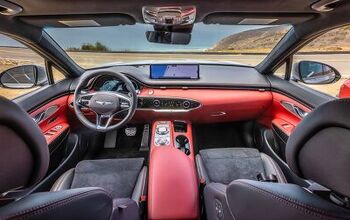2024 Hyundai Elantra N Review: No Grown-Ups Allowed

This is the 2024 Hyundai Elantra N and yes it looks different, and no that’s not all that’s changed here.
Hyundai’s corner rascal has come in for its mid-cycle facelift, and while a quick glance of the spec sheet shows little change, the engineers have made numerous changes under the skin. Since this hot four-door launched three years ago, we’ve seen a redone Civic Type R, its (slightly) more mature Integra Type S sibling, and the rally-inspired Toyota GR Corolla.
Does the Elantra N still feel special amongst this mega-talented group? A week with it confirmed the Elantra N is still the fun-loving punk of the class: rough around the edges, but full of attitude and always down to party.
Quick Take
Blessed with a communicative, well-balanced chassis and a powertrain that begs to be flogged, the facelifted 2024 Hyundai Elantra N remains the hooligan of the sport compact set, and a wicked deal to boot.
2024 Hyundai Elantra N Review: All The Details
What’s New for 2024:
The Elantra N was already arguably the most fun front-driver you could get on the market today. So you’d be forgiven for looking at the 2024 updates press release and getting slightly concerned. It’s properly nerdy stuff: a stiffer engine mount for less vibrations, new bushings for what Hyundai says is “improved yaw response and steering precision,” and a urethane rear suspension insulator. There are better gearbox tolerances that make for better steering feedback and a direct feeling—not that the N was lacking on those fronts.
There are pretty, almost Porsche-like 19-inch alloy wheels at all four corners, reducing unsprung weight by 33 pounds, with wide Michelin PS4s featuring higher tire pressures. The electronically controlled suspension has been retuned to account for all this. It’s all very German and sounds suspiciously like ruthless optimization for better lap times.
Exterior Style:
Most of the visual changes are centered on the front fascia here. Like the rest of the Elantra family, the N now features more horizontal headlights, connected with a thin chrome strip sitting atop a newly bisected front grille. It’s fractionally more mature than the old gaping mouth look, and Hyundai says it improves cooling. Personally, I’m mixed on it: the new setup pulls off a visual trick of looking lower, but it also highlights the inconsistent panel gaps all over the front of the car.
There’s almost a Porsche-like quality to the spindly 19-inch alloys, but it’s hard to notice since they’re flat black.
Very little changes out back; the black-out portion of the bumper now extends further across the sides, and the reflectors have moved up. There’s still the same angular rear wing and two outboard exhaust tips for appropriate touring car vibes.
Powertrain and Fuel Economy:
The engine doesn’t have any more power, and you know what? It doesn’t need it. The Elantra N has kept the weight at bay, so 276 horsepower is plenty, never mind the chunky 289 pound-feet of torque. It is a properly quick car, and it’s one of the better-sounding turbo-fours out there, with a muscular bass with the occasional crackles from the twin exhausts. Funny thing: when I recently drove the Ioniq 5 N again, its simulated Elantra soundtrack had this noticeable turbo flutter on the overrun. I thought it was a glitch in the recording loop, but no, downshift into the meat of the powerband and the Elantra does it.
This tester is equipped with a six-speed manual, and the shifter is pretty good. The throws are a little long, with a bit of a rubbery feel at the lead of each gate, but the weighting is good and it’s easy to speed through when the drive calls for it. The clutch takes some getting used to: the weighting is good, but the bite point is narrow. The optional DCT is excellent, and I wouldn’t begrudge someone for getting it, but this three-pedal setup is still the more interactive. I appreciate that Hyundai has put the rev-matching button right on the wheel for instant access.
Fuel economy is right in line with the rest of the segment: 21 mpg city, 29 mpg highway, and 24 mpg combined. Canadian figures are 11.0, 8.1, and 9.7 L/100 km, respectively. Note that the eight-speed DCT bucks convention and is actually slightly worse on fuel. All the more reason to row your own.
Handling and Drivability:
Don’t you worry about all those : this thing still produces big smiles on the road. This might be front-drive, but it’s blessed with communicative steering, the sort that makes you keenly aware of exactly what those front tires are doing. Trail brake into a corner and the tail still gets involved, just tweaking outward a wee bit to give the front axle a better angle of attack. Ease off the brakes and you feel the grip come back through the rim. It’s so satisfying. The long wheelbase gives the Elantra N stability when you need it, but it’s the suspension tuning that allows it to rotate to naturally. The damping is so well done, keeping the car breathing with the road.
The dedicated N mode in the touchscreen is incredibly in-depth, giving access to lap times and a g-meter, or allowing drivers to tailor the launch mode rpm.
Don’t forget these two blue N buttons either. Here drivers can tailor two custom drive modes, adjusting everything from engine response, suspension stiffness, and more. There are standard drive modes as well. The Elantra N is a parts-bin special in the best way: Hyundai pulled parts from across its vast network that just work. Take the brakes: not Brembos, but still highly effective and showing zero signs of fade after a spirited back-country drive.
Ride Quality and Comfort:
Even though it looks like it escaped from the nearest race track, the Elantra N is reasonably comfortable when pressed into daily grind duty. Yes, the stiffest suspension setting is too harsh for public roads, but why are you using it there?
Dial everything back and the Elantra… tolerates everyday driving. There’s a clear sense it’d rather be off hunting down Mustangs at the track though, with the reminders coming by way of the sharp edge of the 19s tracing every bump, or the ever-present burble of the exhaust. The low nose requires some planning around angled driveways as well.
At least the driver and front passenger will be well supported. The N-branded bucket seats are well-bolstered for the Elantra’s expected mission, yet stop short of being so aggressive as to be annoying for passengers. The back bench is fine: this starts life as a humble economy car, remember. There’s plenty of legroom, though the all-black-everything approach and thick C-pillar makes it cave-like.
Interior Style and Quality:
Is the Elantra’s interior as nice as that in a Civic Type R or Integra Type S? Of course not! It’s also substantially less money than either, and far closer in price to the Si and A-spec. There’s bits of grippy faux-suede all over for a sense of occasion, and of course the supremely supportive bucket seats with the light-up N badges. The rest of it is typical, useful compact car: plenty of space for adults in the back and a huge trunk. Just remember that the N’s bracing doesn’t allow for fold-down seats. Oh well. I do wish it came without a sunroof, too.
Other quibbles that popped up when I wasn’t caning the thing? Even though Hyundai sticks with an old USB-A port for its phone mirroring, I had Apple CarPlay glitch out on me a bunch throughout the week. The rev-matching missed a downshift a couple of times too. Minor stuff.
Tech and Safety:
Hyundai’s now-last-generation infotainment still works well. With a 10.25-inch touchscreen it has large menu items and legible text. There can be some lag, and the satellite radio page is a cramped, awkward experience, but everything else works as expected, Apple CarPlay issues aside. The digital instrument cluster is sharp and features a few different layouts, including track-friendly ones.
My notes on the audio system: “it exists.”
Even with the six-speed, the N doesn’t skimp on safety assists either, including blind-spot monitoring, rear cross-traffic alert, lane keep and follow, and a driver attention warning.
Value Dollars and Sense:
It’s downright shocking the Elantra N remains so affordable. With only the Performance Blue exterior paint inflating the bottom line ($470 / $250 CAD), the as-tested sticker price is $35,320 ($41,924 CAD) including destination. Stick it amongst the affordable sports car quartet we drove in the summer and the Elantra would be the most affordable in the US. Head to a track and none of the other cars would be able to keep its angular rear taillights in their sights.
Final Thoughts:
The changes might be small—and honestly basically imperceptible without a back-to-back comparison—but the 2024 Hyundai Elantra N sticks the landing by keeping Hyundai’s fun and affordable sport compact just that. It prioritizes driving fun above all else, and at this price, I don’t think you could find a better option for a daily driver that can blitz the occasional track day. Yep, the Corner Rascal isn’t growing up, but it is thriving.
Become an AutoGuide insider. Get the latest from the automotive world first by subscribing to our newsletter here.
Category | 2024 Elantra N |
|---|---|
Powertrain | 9 / 10 |
Efficiency | 8 / 10 |
Handling and Drivability | 9 / 10 |
Passenger Comfort | 7 / 10 |
Ride Quality | 4 / 5 |
Exterior Style | 4 / 5 |
Interior Style and Quality | 7 / 10 |
Infotainment | 7 / 10 |
Cargo Capacity and Towing | 3 / 5 |
Safety | 3 / 5 |
Value | 10 / 10 |
Emotional Appeal | 9 / 10 |
TOTAL | 80 / 100 |
Pros | Cons |
|---|---|
Wicked fun | No chill |
Wicked value | Old cabin tech |
Two transmission choices | Reduced practicality |
FAQs
Q: How much horsepower does the 2024 Hyundai Elantra N have?
A: The 2024 model has 276 horsepower, though DCT models have N Grin Shift which adds an extra 10 hp for 10 seconds.
Q: Does the 2024 Hyundai Elantra have cruise control?
A: Yes, when equipped with the dual-clutch transmission.
Q: Is the 2024 Hyundai Elantra N fast?
A: If you mean quick, yes: multiple outlets have timed it in the low 5-second range for the 0–60 mph dash.
Engine/Motor: | 2.0L I4 Turbo |
Output: | 276 hp, 289 lb-ft |
Drivetrain: | FWD |
Transmission: | 6MT |
US Fuel Economy (mpg): | 21/29/24 |
CAN Fuel Economy (L/100 km): | 11.0/8.1/9.7 |
Starting Price (USD): | $34,850 (inc. dest.) |
As-Tested Price (USD): | $35,320 (inc. dest.) |
Starting Price (CAD): | $41,674 (inc. dest.) |
As-Tested Price (CAD): | $41,924 (inc. dest.) |

Kyle began his automotive obsession before he even started school, courtesy of a remote control Porsche and various LEGO sets. He later studied advertising and graphic design at Humber College, which led him to writing about cars (both real and digital). He is now a proud member of the Automobile Journalists Association of Canada (AJAC), where he was the Journalist of the Year runner-up for 2021.
More by Kyle Patrick












































Comments
Join the conversation